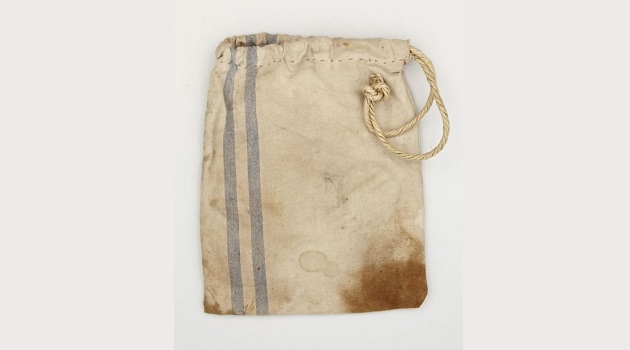Amsterdam, 21 January 2025 – On 27 January 2025, International Holocaust Remembrance Day, it will be eighty years since Soviet forces liberated the Auschwitz concentration and extermination camp. Otto Frank, Anne’s father, was one of approximately 8,000 mostly gravely ill prisoners freed on 27 January 1945. In a 1979 interview, Otto Frank reflected on his liberation from Auschwitz. A cotton bag he brought back from Auschwitz will be displayed in Anne Frank The Exhibition, which opens in New York on 27 January 2025.
In the relatively unknown 1979 documentary Anne Frank wird 50, the 90-year-old Otto Frank looked back on his liberation from Auschwitz and shared: “One day in Auschwitz, I was feeling so depressed that I could not go on. I had been beaten, and it had affected me deeply, morally too. It was Sunday morning, and I said, ‘I cannot get up.’ My comrades – all Dutch, of course, I was a German among Dutchmen, but they accepted me fully – said, ‘You can’t do this, you must get up, or you’re lost!’ Then, they went to a Dutch doctor who worked with a German doctor. The Dutch doctor came to my barracks and said, ‘Get up and come to the infirmary tomorrow morning. I will speak to the German doctor so you can be admitted.’ That’s how it happened and how I was saved.”
A Document Humain
In the same interview, Otto Frank added: “Unfortunately, humanity generally does not learn from the past. But those who can, must contribute to increasing understanding of it, so that lessons can be learned from the past. I still receive letters every day from readers worldwide about Anne’s diary. Whether from Australia, South Africa, the United States, or Japan, it doesn’t matter – that’s the extraordinary part. That’s why I can truly say that Anne’s diary is a document humain (document of humanity). Its content touches people, no matter where they live.”
A Message Against Racism
After his return from Auschwitz, Otto Frank dedicated the rest of his life to sharing his daughter’s diary and opening up the Secret Annex. He particularly wanted to reach young people, hoping they would take action against prejudice and discrimination in their own communities. At the end of the 1979 interview, Otto Frank said: “I see Anne’s diary as a sort of testament. A message against racism, antisemitism, and for understanding people.”
Cotton Bag from Auschwitz in New York Exhibition
In honour of the 80th anniversary of the liberation of Auschwitz, Anne Frank The Exhibition opens on 27 January at the Center for Jewish History in New York. The exhibition highlights Anne Frank’s life and work in the context of the Second World War and the persecution of the Jews. It includes a unique, full-scale reconstruction of the Secret Annex, designed to reflect the hiding period. The exhibition also features more than 100 original items from the collection of the Anne Frank House in Amsterdam. One of these items is the cotton bag that Otto Frank carried on his journey from Auschwitz back to the Netherlands. He held onto it for the rest of his life.
Photo of Otto Frank’s cotton bag from Auschwitz from 1944 (Photo collection Anne Frank House, photographer Harold Strak Stichting).
The Anne Frank House is an independent, non-profit organisation dedicated to the preservation of the place where Anne Frank went into hiding, and to bringing the life story of Anne Frank to the attention of as many people as possible worldwide. It also develops educational programmes for young people based on Anne’s story.



